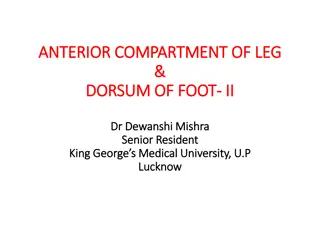Internal Iliac Artery Branches and Ligation Procedure
The internal iliac artery is divided into anterior and posterior branches supplying pelvic organs and regions. The ligation of this artery is clinically important for managing uncontrolled pelvic bleeding in various obstetric and gynecologic conditions. Learn about its branches, indications, and procedural significance.
Download Presentation

Please find below an Image/Link to download the presentation.
The content on the website is provided AS IS for your information and personal use only. It may not be sold, licensed, or shared on other websites without obtaining consent from the author.If you encounter any issues during the download, it is possible that the publisher has removed the file from their server.
You are allowed to download the files provided on this website for personal or commercial use, subject to the condition that they are used lawfully. All files are the property of their respective owners.
The content on the website is provided AS IS for your information and personal use only. It may not be sold, licensed, or shared on other websites without obtaining consent from the author.
E N D
Presentation Transcript
Model Question Answers Model Question Answers Dr. Pushpa S. Koujalagi General Hospital Jayanagar, Bengaluru, Karnataka
1.a) Write the branches of anterior and posterior divisions of internal Iliac artery. b) Describe briefly the procedure and indications of internal iliac artery ligation. 5+5
1 a) Write the branches of anterior and posterior divisions of internal Iliac artery. Internal Iliac artery is branch of common iliac artery and supplies pelvic organs a) Perineum b) Greater part of gluteal region c) Iliac fossa It divides into anterior and posterior branch at 3-5 cm from bifurcation of common iliac artery.
Branches of Anterior division Visceral branches a) Superior vesical artery superior aspect of bladder and distal ureter b) Inferior vesical artery (In males) bladder, prostate, ureter and urethra. c) Uterine artery (In females) uterus, fallopian tube, cervix and vagina. d) Vaginal artery (In females) e) Middle Rectal artery Parietal branches a) Inferior gluteal artery gluteal region muscles b) Obturator artery adductor region of thigh c) Internal pudendal artery perineal artery and inferior rectal artery
Branches of posterior division It supplies posterior abdominal wall, posterior pelvic wall and gluteal region a) Iliolumbar artery psoas muscle, quadratus lumborum, erector spinae and iliac fossa and iliacus b) Lateral sacral artery c) Superior gluteal artery CLINICAL IMPORTANCE: Ligation of internal iliac artery done in uncontrolled pelvic bleeding.
1 b) Describe briefly the procedure and indications of internal iliac artery Indications Obstetric indications 1. Atonic post partum haemorrhage 2. Traumatic PPH Broad ligament hematoma Uterine rupture Angle extension in caesarean 3. Abruptio placenta 4. Placenta previa 5. Placenta accreta, increate, percreta Gynaecological indication 1. Gynaecologic oncologic procedure a) Mass or tumour at the deeper part of pelvis b) Radical hysterectomy c) Extended radical hysterectomy 2. Intractable pelvic haemorrhage
Procedure of internal iliac artery ligation Surgery : internal artery ligation Type of anesthesia: under general anesthesia Incision :midline or transverse incision Steps: Under strict aseptic precaution ,parts painted and drapped in supine position. Abdomen opened in layers by sharp and blunt dissection. General peritoneum separated and bladder pushed down. Entering retroperitoneum- the lateral parietal peritoneum over the pelvic side wall between round ligament and infundibulopelvic ligament is cut.
During this step uterus is pulled towards the counter side of the pelvic wall where we plan to enter the retroperitoneum . The incision is extended cranially to the level of pelvic brim parallel to the infundibulopelvic ligament. Posterior leaf of broad ligament is retracted medially so the retroperitoneal area is visualised. Identification of ureter and internal iliac artery-ureter runs on the posterior leaf or base of the broad ligament under ovarian vessels,medial to anterior branch of internal iliac artery. Ligation of internal iliac artery at 5cm distal to the common iliac artery bifurcation will usually avoid the posterior division branches. The areolar sheath of the artery is incised longitudinally and right angled clamp(Martinez clamp) is carefully passed just beneath the artery from lateral to medial.
Care must be taken not to perforate large veins and ureter. The ureter and external iliac artery are rechecked and finally the suture is tied carefully. Non absorbable suture is used for ligation. The procedure is repeated on the contralateral side. Mechanism of action a) Ligation of internal iliac artery causes 85% reduction in pulse pressure in those arteries distal to ligation. b) This converts an arterial pressure system into one with pressure approaching those in the venous circulation. c) This creates vessels more amenable to hemostasis via pressure and clot formation.
3. a) Role of imaging in adenomyosis. b) Indications and challenges of elective single embryo transfer ( eSET ) 5 +5
3 a) Transvaginal Sonography 3 a) Transvaginal Sonography Now Diagnosis of Adenomyosis By International Morphological Uterus Sonographic Assessment (MUSA) criteria 1. Asymmetrical myometrial thickening 2. Myometrial cysts 3. Hyperechoic islands 4. Fan shaped shadowing 5. Echogenic subendometrial lines and buds 6. Translesional vascularity 7. Irregular junctional zone 8. Interrupted junctional zone
Diffuse adenomyosis a. Anterior (or) posterior myometrial wall appearing thicker than its counter part b. Myometrial texture heterogenesity c. Small myometrial hypoechoic cysts which are cystic glands within ectopic endometrial foci. d. Striated projections extending from the endometrium in to the myometrium. e. Ill defined endometrial echo border f. Globally enlarged uterus g. Color (or) power doppler shows diffuse vascularity in affected myometrium. Focal Adenomyosis Appears as a discrete hypoechoic nodule that may sometimes be differentiated from leiomyomas by its poorly defined margins, elliptical shape, minimal mass affects on surrounding tissue, lack of calcification but presence of small anechoic myometrial cysts. SENSITIVITY 80-86% SPECIFICITY 50-96% OVERALL ACCURACY 68-86%
MRI It is the best modality of diagnosis T2 weighted image shows ill defined relatively homogenous low signal (hypoechoic) areas embedded with scattered high intensity spots in the uterine wall Homogenous junctional zone thickness >12mm with hemorrhagic high signal myometrial spots is highly predictive SENSITIVITY 86 -100%, OVERALL ACCURACY 85-90 % HYSTEROSALPINGOGRAPHY Multiple spicules 1-4mm extending myometrium and ending in the small sacs Seen in 25% cases only and its not diagnostic Magnetic Resonance Imaging from endometrium to
b) Indications and challenges of elective single embryo transfer ( eSET ) 3b) 3b) Definition Definition Elective SET is defined as the transfer of single embryo- at either cleavage or blastocyst stage of embryo development and is selected from a larger number of available embryos Indication 1. Woman s age less than 35 years 2. First assisted reproductive technology 3. Previous ART success 4. Relatively large number of high quality embryos generated 5. Having embryos available for cryopreservation
Challenges Challenges Physician or Staff education Patient education Financial consideration Embryo Selection Successful cryopreservation a) A successful embryo cryopreservation program is critical practical application of eSET b) Without the ability to store viable embryos for later use,eSET would be difficult to support
Physician or Staff Education Clinician are often reluctant to encourage SET for their patients because of the concern that pregnancy rates will suffer as a result. Provides all levels of patient interaction would benefit from the knowledge of the literature demonstrating that high cumulative Pregnancy rates-can be maintained with eSET for selected patients Patient Education Patient education is vital for accepting eSET and presents a practical challenge Patients prefer twin pregnancy over singleton pregnancy due to potential reduction in PRs with SET Such attitudes may be due to misconceptions that underestimating the efficacy of eSET and the risks and health consequences associated with multiple pregnancies
Financial Consideration It may also motivate patients to desire transfer of multiple embryos Multiple IVF cycles and their cost limiting eSET Increased availability of insurance coverage for infertility treatment could help to reduce financial burden to eSET Embryo Selection Successful implementation of eSET depends on ability to select the most viable embryos The selection of the best embryo for transfer continuous to rely on morphological evaluation which has recognized shortcomings Many morphologically high quality embryos fail to implant and some seemingly poor quality embryos results in healthy live births
Thank You Thank You























